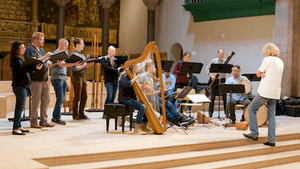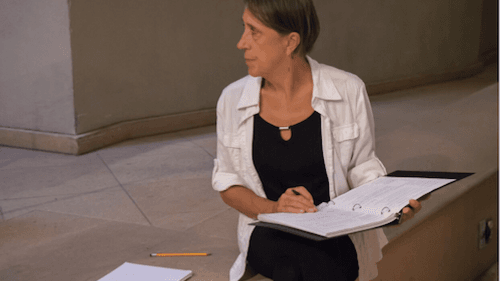Stay in the Loop
BSR publishes on a weekly schedule, with an email newsletter every Wednesday and Thursday morning. There’s no paywall, and subscribing is always free.
'Don Quixote' goes onstage
Piffaro, the Renaissance Band, presents 'The Musical World of Don Quixote'

The Musical World of Don Quixote opens in a week. The last details are falling into place; guest performers are on their way.
Last week, Piffaro’s Joan Kimball, Bob Wiemken and Grant Herreid (trailed by a lighting designer and stage director) roamed the high-arching, creamy-stone-and-sparkling-lights interior of West Philadelphia’s Episcopal Cathedral. A recent renovation gave the cathedral an open floor plan that allows dramatic staging. Now, the group’s deciding where to place 15 players and singers for more than a dozen musical numbers.
Kimball, Piffaro co-artistic director, points to a place next to the altar. “For the opening, the three shawms can stand there,” she says. It’s got the sightlines for a great, bombastic fanfare.
“Next, Nell, Charlie, and Grant can stand over here, in the middle,” Kimball says. That’s guest soprano Nell Snaidas, accompanied by Charles Weaver and Herreid on guitar in an air de coeur — literally “song of the heart” — to the Quixotean lyrics, “Yo soy la Locura” (“I am madness that fills the world with pleasure”). Wind players will move in to back up on recorders, mellow low brass, and harp.
Kimball is counting imaginary players across the area. “The guys and everyone else will come in from the left for the knight song. We’ll need the whole space, all the way across,” she says. This will be the first big number for the whole band that includes Piffaro’s full contingent of six wind players plus guests Eric Schmalz on brass and Josep Borras on reeds, Snaidas, Weaver, a capella men’s quartet New York Polyphony (two-time Grammy nominees), and percussionist and hand-drum virtuoso Glen Velez (five-time Grammy winner).
“That’s it, percussion and winds and string and guitar and everybody wailing away,” says co-director Wiemken. Three numbers down, 10 minutes in and the rafters will already be ringing.
Kimball, Wiemken and Grant Herreid continue, figuring out how to place solos, group numbers, a sword dance, love songs, a chain gang, and a whipping for poor Sancho Panza.
Below The Musical World
They make it look easy. But after six months of being a fly on the wall, I know better. I’ve been figuring out a ratio of hours of entertainment to preparation. It’s ridiculous, like two to 12,000.
There’s a huge iceberg of hard work below The Musical World of Don Quixote. The very nature of the project — performing the book’s scenes where Cervantes mentions music — is a great idea, but it’s also full of pitfalls. One of the problems is that nobody is sure of what Cervantes really had in mind, musically speaking.
There’s a whole lot of music in Don Quixote because Cervantes was the kind of writer who loves making popular culture allusions, popular songs in particular. He can’t possibly have realized that the book would last so much longer than the songs. Don Quixote has been in print for 400 years, but Spanish Golden Age music disappeared almost immediately. Most of the songs are lost, along with all that juicy extra-textual color that Cervantes expected us to get from them.
Academics have only started to take up the brunt of figuring out the book’s original music. There’s no songbook for Don Quixote, not yet anyhow. Musicians like Piffaro’s are pioneers with shows like these, exploring libraries and manuscripts with steady determination, love of the chase, and musicological detective skills.
Piffaro’s Grant Herreid has all of these. The songs in The Musical World of Don Quixote represent an evolving body of work he’s developed and performed for decades with Piffaro, other groups, and his Yale students. After decades of immersion in Golden Age musical culture, he holds a treasure-trove of old tunes and words in his head.
Some of his finds will be onstage for the first time this week. When we see the scene in which Don Quixote and Sancho encounter chained slaves on the road, we’ll hear the "Romance de los Presos de la Cárcel," or a version of it, that may have been just what Cervantes was referencing. It actually clarifies some of his dialogue.
Early music, old friends, new friends

To Snaidas, as to many others who grew up in Spanish-speaking homes, Don Quixote is part of life.
“Don Quixote and all those characters were just kind of alive in our house,” says Snaidas. “We’d be getting gas at the station, and something would happen and my father would laugh and say, ‘You know, it’s like the time when Don Quixote and Sancho Panza….’”
One of the roles Snaidas will sing is the temptress Altisidore, who tries to seduce Don Quixote through song (NY Polyphony bass Craig Phillips will sing Quixote). It’s an important part of the story, but Cervantes never indicated a tune. Thanks to Herreid’s ability to reconstruct old songs, we will finally hear a 17th-century song so beautiful it almost won Don Quixote’s heart.
Snaidas says that to inhabit these characters herself, on this special year — the 400th anniversary of Cervantes’s death — and with lifelong friends, is exceptional, “incredible.” For her, it’s the chance to revisit one branch of the family in the warm company of another, and in turn, to welcome the rest of us into Don Quixote’s musical world.
Editor's note: This article is the third in a series about Piffaro's work in progress, leading up to the October debut. The series is being presented on Broad Street Review in partnership with Piffaro. The Musical World of Don Quixote has been supported by The Pew Center for Arts and Heritage.
To read the first article in this series, click here.
To read the second article in this series, click here.
What, When, Where
The Musical World of Don Quixote. Through Oct. 9, 2016 at the Philadelphia Episcopal Cathedral, 38th and Chestnut Sts., Philadelphia. (215) 235-8469 or piffaro.org.
For an in-depth look at The Musical World of Don Quixote, piffaro.org for exhibitions in Philadelphia for the Don Quixote Festival weekend (October 7 to 9) and a symposium at the University of Pennsylvania’s Kislak Center for Special Collections, Music, Word and Art in the Age of Cervantes, that features America’s foremost scholar on Spanish music of the period, Louise K. Stein, and Don Quixote translator, Edith Grossman, among others.
Sign up for our newsletter
All of the week's new articles, all in one place. Sign up for the free weekly BSR newsletters, and don't miss a conversation.
 Anne Schuster Hunter
Anne Schuster Hunter